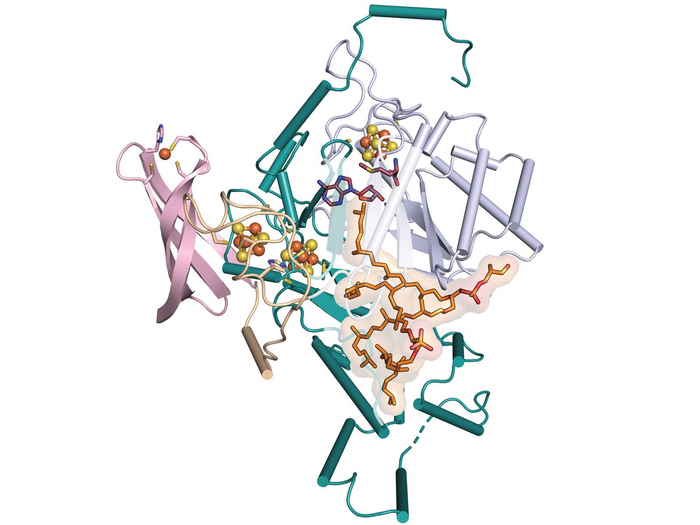The missing step in the formation of a lipid molecule that allows certain single-celled organisms to survive the most extreme environments on Earth has now been deciphered. This new understanding, uncovered by a team of biochemists from Penn State and the University of Illinois Urbana-Champaign, could improve the ability of the lipids to be used as an indicator of temperature across geological time.

Credit: Booker Lab / Penn State
The missing step in the formation of a lipid molecule that allows certain single-celled organisms to survive the most extreme environments on Earth has now been deciphered. This new understanding, uncovered by a team of biochemists from Penn State and the University of Illinois Urbana-Champaign, could improve the ability of the lipids to be used as an indicator of temperature across geological time.
The lipid, called glycerol dibiphytanyl glycerol tetraether (GDGT), is found in the cell membrane of some species of archaea, single-celled organisms that were originally thought to be bacteria but now are considered a separate group. This lipid provides the stability for some species to thrive in environments with extremely high temperatures, salinity or acidity, like thermal vents in the ocean, hot springs and hypersaline waters. The unique stability of GDGT also allows it to be detected hundreds or even thousands of years after the organism dies. Because these organisms tend to produce more GDGT at higher temperatures, it is considered a promising candidate for estimating temperature over geologic time.
“For GDGT to be accurately used as a proxy to reconstruct changes in geological temperatures, scientists need to better understand how it is made, what genes code for it, and which species can create it,” said Squire Booker, a biochemist at Penn State, an investigator with the Howard Hughes Medical Institute, and leader of the research team. “But, until now, there has been a missing step in the formation of this lipid. We used imaging techniques coupled with chemical and biochemical methods to deconstruct the chemical pathway for this missing step.”
GDGT’s stability is in part due to its two long hydrocarbon chains that extend throughout the membrane. But how these two chains become linked together has puzzled scientists for decades.
“Coupling the carbons at the end of the two hydrocarbon chains is really challenging chemistry because they are inert — they are chemically inactive,” said Cody Lloyd, a graduate student at Penn State and a member of the research team. “We identified the enzyme that activates these terminal carbons and makes this coupling possible. Additionally, we now know the gene that encodes this enzyme, which should improve the use of GDGT as an indicator of past climates.”
The enzyme that facilitates the coupling of the two hydrocarbon chains belongs to a class of proteins called radical SAM proteins, which are known to play an important role in a variety of chemical reactions, including the production of antibiotics, the modification of proteins, DNA and RNA, and the creation of various biomolecules.
The first step is similar to that of other reactions that involve radical SAM enzymes: the radical SAM enzyme uses one of its iron-sulfur clusters to cleave a molecule called S-adenosyl-L-methionine (SAM), producing a “free radical” or an unpaired electron that is highly reactive and helps move the reaction forward. Then, the radical plucks a hydrogen atom off the carbon at the end of the chain. At a later step, this process repeats with the second chain using a second molecule of SAM.
“Ultimately, the carbons at the end of each of the chains end up binding to each other at the position where the hydrogen atoms were removed,” said Lloyd. “But once the hydrogen on the first chain is removed, it becomes so unstable that it could react with pretty much anything. To temporarily keep the first chain from reacting with any off-targets, the carbon binds to a sulfur atom from another one of the enzyme’s three iron-sulfur clusters.”
Once the hydrogen has been removed from the second chain, the resulting radical encourages the first chain to remove itself from the iron-sulfur cluster on the enzyme and instead bind to the second chain. This results in the two chains being bound together, completing the missing step in GDGT’s formation. The researchers present their results in a paper appearing online and in print in the Sept. 1 issue of the journal Nature.
“This is a completely novel use of an iron-sulfur cluster, and this is the first example in nature of the coupling of two completely inert carbon atoms with this electron configuration, which chemists call sp3 hybridized,” said Booker. “There has been a lot of interest in creating these kinds of carbon-carbon bonds from sp3-hybridized carbons as part of pharmaceuticals and other industrial products. Nature has had millions of years to figure this stuff out, so we continue to look to nature for inspiration for synthetic reactions — like this novel use of an iron-sulfur cluster.”
Booker is an Evan Pugh University Professor of Chemistry and of biochemistry and molecular biology, and holder of the Eberly Distinguished Family Chair in Science at Penn State. In addition to Booker and Lloyd, the research team at Penn State includes research scientists David Iwig and Bo Wang and Amie Boal, professor of chemistry and of biochemistry and molecular biology. The research team at the University of Illinois Urbana-Champaign includes Matteo Cossu, postdoctoral researcher; and William Metcalf, G. William Arends Professor in Molecular and Cellular Biology and professor of microbiology.
This research was funded by the National Institutes of Health, the Penn State Eberly Family Distinguished Chair in Science, and the Howard Hughes Medical Institute.
Journal
Nature
DOI
10.1038/s41586-022-05120-2
Method of Research
Experimental study
Subject of Research
Not applicable
Article Title
Discovery, structure, and mechanism of a tetraether lipid synthase
Article Publication Date
1-Sep-2022




